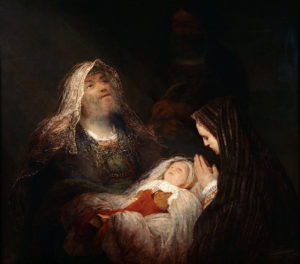Thoughts on Sunday’s Lessons for Feb. 2, 2020
First Reading: Malachi 3:1-4
The feast of the Presentation of our Lord falls 40 days after Christmas. When it falls on a Sunday, as it does this year, it takes precedence over the usual liturgy for the season of Epiphany.

Simeon’s Song of Praise, Nunc Dimittis (c.1700-c.1710). Oil painting on canvas by Aert de Gelder (1645-1727). Royal Picture Gallery Mauritshuis, The Hague, Netherlands. (Click image to enlarge.)
The readings reflect on the presentation of the baby Jesus and the ritual purification of his mother, Mary, in the Jerusalem temple. First we hear the Prophet Malachi speak of purification too, using the metaphor of a refiner tho purifies gold and silver with heat and fire: poetic words that the composer Handel will later adopt for a beautiful aria in The Messiah. For Malachi, the refiner’s cleansing fire stands as a symbol of Israel’s duty to restore the Temple and its priesthood upon the people’s return from exile.
Psalm: Psalm 84
Consider this psalm from two perspectives as we hear it: We may regard it from our own perspective, singing out our joy in knowing that God will provide protection, favor and honor to us when we trust in God. But think, too, about the perspective of creation: God provides nests for the small birds, for sparrows and swallows too. God hears not only our prayers, but provides pools of water for thirsty travelers and for all creatures who thirst as they go through desolate valleys.
Alternate Psalm: Psalm 24:7-10
This passage comes from one of the many psalms that tradition attributes to King David himself. The full psalm is thought to have been a processional chant as the priests and congregation approached the Temple. In the first verses the priest calls out, “Who shall stand in his holy place? Who has the right to come in and worship? “Those who have clean hands and pure hearts,” the crowd sings back. Then, in the verses we hear on this Sunday, the joyous chorus celebrates God, the King of Glory, creator of the earth and all that is in it.
Second Reading: Hebrews 2:14-18
Christians in some parts of the Roman Empire faced frightening persecution late in the 1st century, a situation that prompted many Jewish Christians to abandon their new faith and return to Judaism, which at the time was not under such severe persecution. The Letter to the Hebrews urges them to stay strong and persevere in faith. It names Jesus as Son of God and great high priest, God who became fully human like us and freed us from death through his sacrifice and resurrection. Because Jesus was so tested, the writer of Hebrews argues, Jesus will help those who are being tested.
Gospel: Luke 2:22-40
Now Joseph and Mary come to the temple for her ritual purification and to present the infant Jesus in accord with the practice that a firstborn son be presented to God. They offer two small birds as sacrifice, an option reserved for poor families who couldn’t afford a lamb. Then Simeon enters. An elderly man, Simeon had heard the Holy Spirit’s promise that he would see the Messiah before he died. He joyfully takes the baby, blesses Jesus and his family, and utters the verses that we know as the Nunc Dimittis, the Song of Simeon: “Lord, you now have set your servant free to go in peace as you have promised; For these eyes of mine have seen the Savior, whom you have prepared for all the world to see.”
